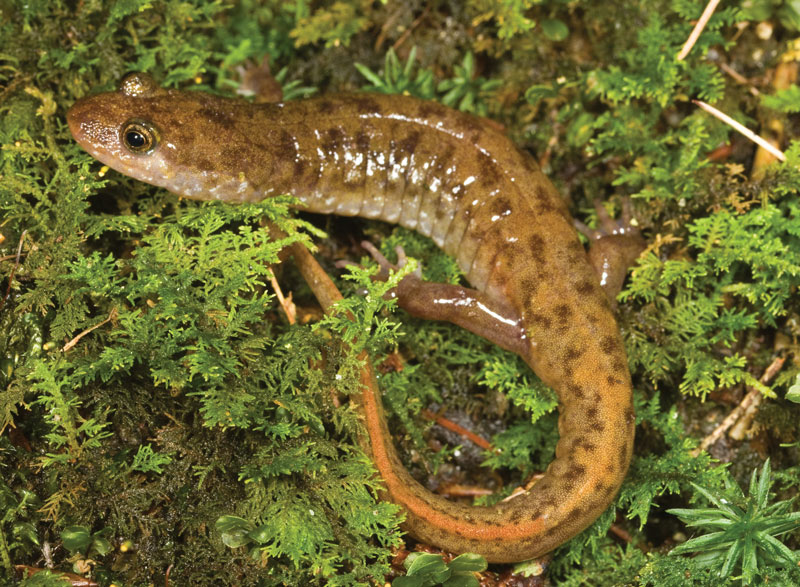
The seal salamander (Desmognathus monticola) is among the variety of species that reside in the southern Appalachian Mountains. North America boasts the world’s highest count of salamander species — 191, currently — and the elusive amphibians are present in every state except Alaska and Hawaii. Photo by Bill Peterman
Hundreds of beady eyes beamed back at Brian Stiehler, CGCS, as he stood by a stream at Highlands (N.C.) Country Club on a clear, damp night in June 2009. The superintendent was accompanying a researcher from the University of Missouri, in town to survey salamander populations on the western North Carolina course. Because the amphibians are nocturnal, effective investigation required a cloak of darkness.
“He shined a flashlight out on the stream, and it was incredible — just all these eyes sticking out of the water,” says Stiehler. “I had no idea there would be that many salamanders. It was an a-ha moment. I look at them in a completely different way now.”
The 20-year GCSAA member had always known some sizable number of salamanders called Highlands home. After all, the 18-hole course sits just outside Great Smoky Mountains National Park, often billed as the salamander capital of the world. Highlands’ 200 acres of Appalachian temperate rainforest — complete with 96 inches of annual rainfall — are indeed hospitable habitat for salamanders and a host of other organisms. Throughout his 16 years at the club, Stiehler has even had a handful of encounters with the stealthy, slender-bodied creatures during daylight hours. That summer’s night sighting along the stream, however, proved illuminating — as would the findings of the research efforts tied to it.
Published in the May 2014 edition of the journal Landscape and Urban Planning, the study, conducted at 10 North Carolina golf facilities over several summers, examined the impact of the courses on stream salamanders by taking stock of salamander abundance and diversity upstream of fairways, in sections of stream passing through fairways, and downstream of fairways.
“No results are sometimes good things,” says Bill Peterman, Ph.D., co-author of the study (with Mark J. Mackey and others) and now an assistant professor of wildlife ecology at Ohio State University. “In this case, we couldn’t discern any difference upstream vs. downstream — they were, in most regards, identical in terms of population and diversity.” This suggests, says Peterman, that, contrary to common opinion, golf courses and the practices used to maintain them are not inherently hindrances to wildlife conservation and biodiversity. On the tracts of stream on the fairways themselves — which lack tree cover and other characteristics salamanders prefer — researchers did observe a drop in abundance, yet diversity was comparable.
What lends these findings heightened significance is that salamanders are what’s known as an “indicator species.” Given their blend of aquatic/terrestrial living along with their high sensitivity to contamination of and changes to their habitat (destruction, fragmentation), they serve as a good gauge of their ecosystem’s overall health. The lungless family of salamanders Peterman and his colleagues focused on in North Carolina is a particularly telling barometer, as they breathe exclusively through their skin, which elevates their vulnerability to their surroundings. (Researchers found no negative effects from herbicides or pesticides downstream of the courses.) A consistent, healthy presence of salamanders thus makes a compelling case for the health of the ecosystem both upstream and downstream of the golf courses.
For Stiehler, the study’s revelations and the experience of participating in it have fostered a stronger commitment to environmental stewardship, and just a few tweaks around Highlands have helped optimize the space for salamanders. Stiehler no longer removes the leaves and other minor plant debris that collect in streams, as researchers noted a correlation between the salamanders’ abundance and diversity and the leaf litter depth and amount of woody debris in and around those course features. The accumulation provides shelter and attracts the small invertebrates that salamanders forage on. (For every one salamander you might spot during daytime, Peterman says five to 10 are likely lurking undetected in the vicinity.)
At Highlands, well-known best management practices such as keeping applications on target and establishing buffer zones now have a tangible “why” attached to them — the beings behind all those beady eyes. “Salamanders are what make this place special,” Stiehler says. “I always thought everything I did was environmentally friendly, but you never really know until you understand all the dynamics. Superintendents have to see the big picture, because we have the ability to affect a lot of things outside of what we’d consider our everyday jobs.”
Stiehler’s big-picture takeaway? Let landscapes remain natural whenever feasible, allowing what he dubs the “disorganized beauty” of something like an untidied stream to shine through. “We have this perception that everything about golf courses is man-made,” Stiehler says. “In trying to have everything so perfect, we’re trying to re-create something that’s not natural. We can just accept that some things are how they are, and that they’re like that for a reason.”
Megan Hirt is GCM’s managing editor.